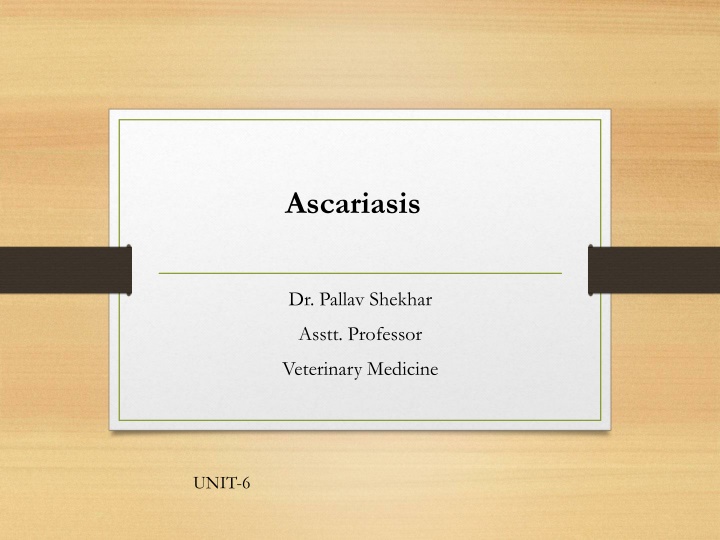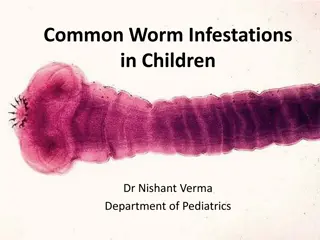
Ascariasis: Causes, Symptoms, and Treatment in Animals
Ascariasis is a common parasitic infection affecting pigs, horses, cattle, and other animals. Dr. Pallav Shekhar, an Assistant Professor in Veterinary Medicine, explains the etiology, life cycle, pathogenesis, and clinical findings of Ascariasis. Learn about how animals get infected, the symptoms to watch out for, and the importance of early treatment.
Download Presentation

Please find below an Image/Link to download the presentation.
The content on the website is provided AS IS for your information and personal use only. It may not be sold, licensed, or shared on other websites without obtaining consent from the author. If you encounter any issues during the download, it is possible that the publisher has removed the file from their server.
You are allowed to download the files provided on this website for personal or commercial use, subject to the condition that they are used lawfully. All files are the property of their respective owners.
The content on the website is provided AS IS for your information and personal use only. It may not be sold, licensed, or shared on other websites without obtaining consent from the author.
E N D
Presentation Transcript
Ascariasis Dr. Pallav Shekhar Asstt. Professor Veterinary Medicine UNIT-6
Ascariasis in Pig, Horses and Cattle Neoscariasis Ascariasis Parasacariasis
It is species sp. parasite Each host sp. has its own ascaris nematodes They are the largest intestinal parasites of cattle, buffalo, sheep, goat, pig and horses Female are 30cm long and male are 25cm long
Etiology Ascaris suum Pig Parascaris equorum Horse Toxocara vitulorum Cattle and Buffalo Ascaris lumbricoides Man/Sheep Toxocara canis Dog
Life cycle-1 Lays large no. of Eggs Eggs hatch in intestine Adult Worm S.I swallowed Migrate via intestinal wall to portal vein and to liver Hepatic venous system Bronchial tree Lung larvae Pharynx Swallowed Intestine Mature adult worm
L/C-2 No development or growing of larvae Settle in somatic cells Larvae Larvae activated and migrate to udder Pass to colostrum During Calving Grow to adult parasite in intestine of calf Taken by calf
Pathogenesis The migration of Ascaris larvae through Liver and Lung leads to fibrosis and haemorrhage of the respective tissue. In lung oedema and consolidation of the alveoli may also occurs.
Epidemiology Pigs & Horses gets the infection from the ingestion of infected larvated eggs Toxocara Vitulorum larvae are present in greatest no in the colostrum 2 to 5 days after calving. These larvae are ingested by calves along with the colostrum which develops in adult worm in their intestine about 10days age of the calves. The worm started laying eggs which are passed by 3 weeks. Toxocarriosis is a calf hood disease. The disease is especially important in buffaloes calves and Pup. Mortality is moderate in adult and high in neonates
Clinical Findings A febrile and Intermittent diarrhoea Obstructive jaundice Some time intestinal obstruction Sometime coughing of the worm Inzootic pneumonia and Swine influenza accompanied by Ascariasis. In calves and foals similar sign to pigs may also occurs.
Ascarid eggs are brown and have thick walls with a pitted surface. Sub pleural haemorrhage, oedema and congestion of lung. Blood stained fluid in peritoneal cavity. In chronic cases liver capsule has marked white spot. The necrotic tissue are replaced by fibrotic tissue. Necropsy Increase eosinophilia and decrease Hb. Pathology Diagnosis
Treatment PIGS, CATTLE, HORSE Anthelmentic mentioned earlier Pyrantel is the drug of choice for treatment of T. vitulorum as it has good efficacy against both mature and immature worms BUFFALO CALVES Ivermectin, Piperazine and Levamisole are also effective
Control Deworming of calves in 3rd to 6 weeks of age. Pregnant dams of all domesticated animals and Pets should be dewormed during that period as deeply imbedded hypobiotic larvae comes out during that period.
Canine Ascariasis Etiology Toxocara canis Toxocara leonina
Puppies are highly susceptible as compared to adult Adult parasites are present in S.I
Transmission By ingestion of L2/L3 stage. Transplacental transmission Transcolostral
L/C Larva moult to L2 stage Adul tworm Lay eggs Passed in stool L3 stage (infective) Contamination of feed and water and skin of animals Release of L2 and L3 stage Egg hatch intestine ingestion Penetrates wall of mucosa Enters portal vein Liver Heart General Circulation
L/C in adult dog and bitches G. Circulation Somatic migration L3 stage Liver Heart Kidney Muscle
Cont. Bitch is pregnant 42 days of pregnancy All larvae comes in circulation placenta Developing foetus
Cont.. Intestine of pup Portal vein and liver of pup udder In colostrum circulation Rupture of alveoli and capillaries Mould to L4 stage bronchiole lung heart trachea mouth Re-swallowed stomach bronchi Adult worm L5 stage intestine
Pups less than 5 weeks of age above mention cycle occurs Pups greater than 5 weeks of age somatic migration occurs For T. leolina similar L/c but no migration of larvae
Pathogenesis In Liver milky white spot k/a spotted liver Mild enteritis Intestinal obstruction or intestinal perforation
Clinical findings Sudden death in pups Occasional vomition Dehydration Rough hair coat Pot belly Pnemonia
Treatment Piperazine @ 100-300mg/kg orally Pyrantel pamoate @ 5mg/kg b.wt at 2-3 weeks of age and repeated at 4, 6, 8 weeks

